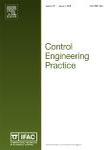版权所有:内蒙古大学图书馆 技术提供:维普资讯• 智图
内蒙古自治区呼和浩特市赛罕区大学西街235号 邮编: 010021

作者机构:Univ Polytech Hauts De France LAMIH Lab UMR CNRS 8201 Valenciennes France INSA Hauts De France Valenciennes France Univ Lille CRIStAL Lab DEFROST team INRIACent LilleUMR CNRS 9189 Villeneuve Dascq France
出 版 物:《CONTROL ENGINEERING PRACTICE》 (控制工程实践)
年 卷 期:2023年第138卷第1期
核心收录:
学科分类:0711[理学-系统科学] 0808[工学-电气工程] 07[理学] 08[工学] 070105[理学-运筹学与控制论] 081101[工学-控制理论与控制工程] 0811[工学-控制科学与工程] 0701[理学-数学] 071101[理学-系统理论]
基 金:European Community Delegation Regionale a la Recherche et a la Technologie Ministere de l'Education Nationale, de la Recherche et de la Technologie, France Hautsde-France region Centre National de la Recherche Scientifique, France University of Lille, Centrale Lille, France
主 题:Soft robots LPV control Motion control Data-driven modeling Model order reduction RBF networks
摘 要:We propose a generic nonlinear reduced-order tracking control method for elastic soft robots. To this end, a new linear parameter varying (LPV) control framework is developed using the data collected from the soft robots. Specifically, for LPV modeling we first derive a nonlinear robot model, which is large-scale by nature, using finite element methods (FEM). Then, a proper orthogonal decomposition (POD) algorithm is used to generate a set of linearized reduced-order models, representing the local behaviors of the soft robot at different operating points within the workspace. Via a unified POD projector, not only the order of these linearized models can be significantly reduced but also their mechanical structure and stability properties can be preserved for LPV modeling and control design. Next, using radial basis function (RBF) networks, we propose an iterative training method to build the LPV robot model by interpolating a subset of selected linearized models with a specified interpolation error. For LPV control design, the equivalent-input-disturbance (EID) concept is exploited to develop a dynamic tracking control scheme, which is composed of three core components: feedforward control, disturbance-estimator control and feedback control. The feedforward control is designed to account for the effects of the trajectory reference and the time-varying affine term, issued from the FEM-based model linearization. The disturbance-estimator control is obtained from a generalized proportional integral LPV observer, which also provides the estimated reduced-order states for feedback control. The observer-based feedback control design is reformulated as a convex optimization problem under linear matrix inequality (LMI) constraints. The globally uniformly ������stability of the closed-loop LPV robot model is guaranteed by means of Lyapunov stability theory. Experimental tests are conducted with a soft Trunk robot, inspired by the elephant trunk, under several scenari